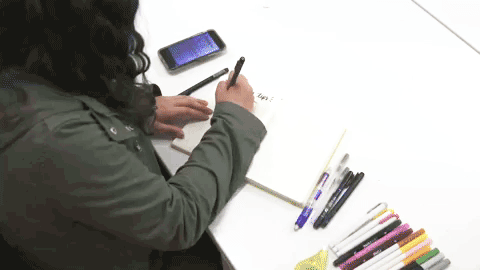If you’re a student looking for the most advanced learning machine available, give laptops a pass — and pick up an age-old notebook.
You’ll absorb and retain more information if you take notes by hand, according to a study by UCLA, giving you an edge on your tests.
That spiral-bound stack of paper has other advantages, too: You can’t zone out on Facebook and Instagram during a lecture, so you are more likely to stay focused.
Putting pen to paper requires a different kind of mental processing than typing does. Sure, typing on a laptop gives you the power to record a lecture nearly word for word — but transcribing verbatim is associated with what’s called “shallow cognitive processing.” The words may be captured on your screen, but they basically went in one ear and out the other.

Frida taking notes.
Taking notes by hand is more likely to be “generative.” Because you can’t write down everything you hear, you tend to condense information into useful forms, like summarizing, paraphrasing and concept mapping. Born of necessity, this kind of note-taking is more creative, and it forces your brain to engage more deeply with the information.
Frida Hernandez, a student at UC Berkeley, is a note-taker extraordinaire. Her notebooks are proof positive that taking notes doesn’t have to be boring.
“I’ve always taken notes by hand ever since I can remember,” Frida says. “It’s just something that I picked up because I love to write and because I didn’t really have my own laptop until my senior year of high school.”
Getting her own laptop for college didn’t really disrupt her process. She tried using it during lectures, but ended up going back to her notes. “It’s a lot easier to study information that I already processed rather than just text that I copied directly from the slides with no additional notes or visuals.”
Frida’s journals display many of the information processing techniques covered by the UCLA study. She makes mind maps, timelines and drawings, and uses different colors to signify the connections she hears during the lecture. Pen and paper give her more control over how she structures the information. She likes it so much that that she looks forward to classes more because of her note-taking style.
“I know that handwriting my notes keeps me engaged with the material so I’ll actually be able to get more out of the lecture in the end,” she says. In fact, her neat, handwritten style has so impressed teachers she’s even helped them write notes on the board in the past. Most importantly, she’s noticed since coming to UC Berkeley that taking notes by hand has really helped her studying.
For the doubters out there, Frida has some advice: “Just try it! The great thing about taking handwritten notes is that anyone can start with the supplies they likely already have.” And if you prefer a high-tech solution, you can always take notes with a tablet and stylus: Frida uses iPad and Apple Pencil for graphically complex classes.
And as for the pressing question, “Pen or pencil?” Frida says: Pen.
Straight from the expert. We hope you’re taking notes.

